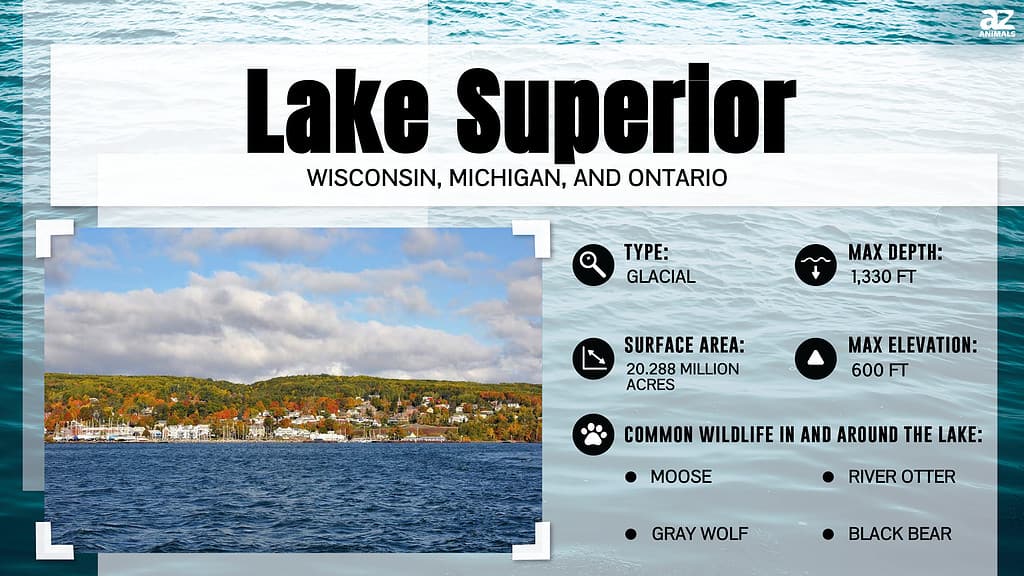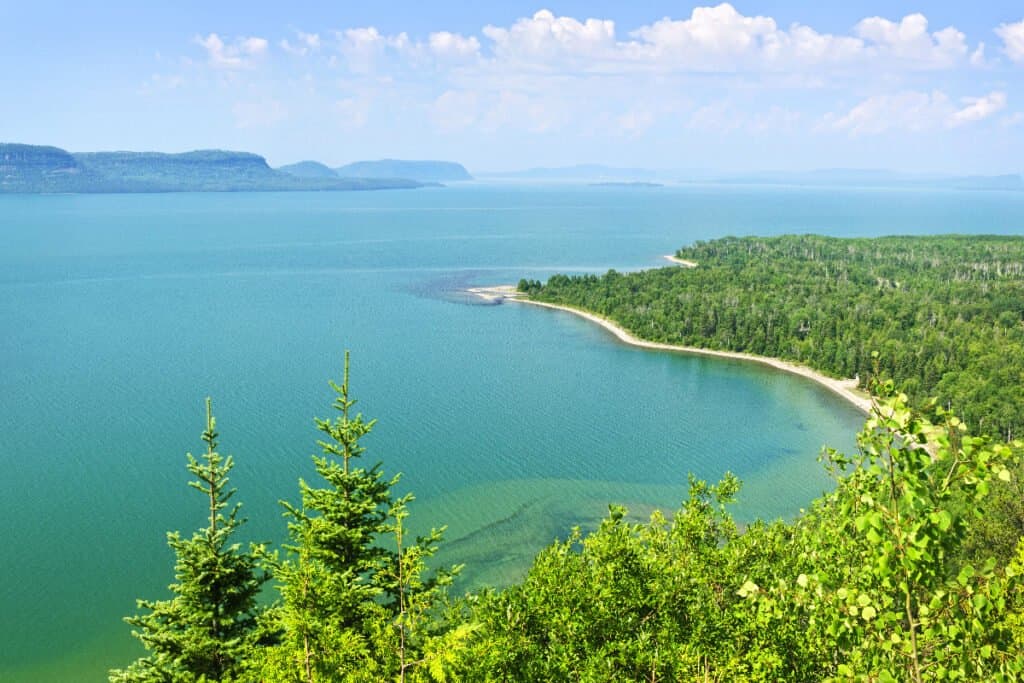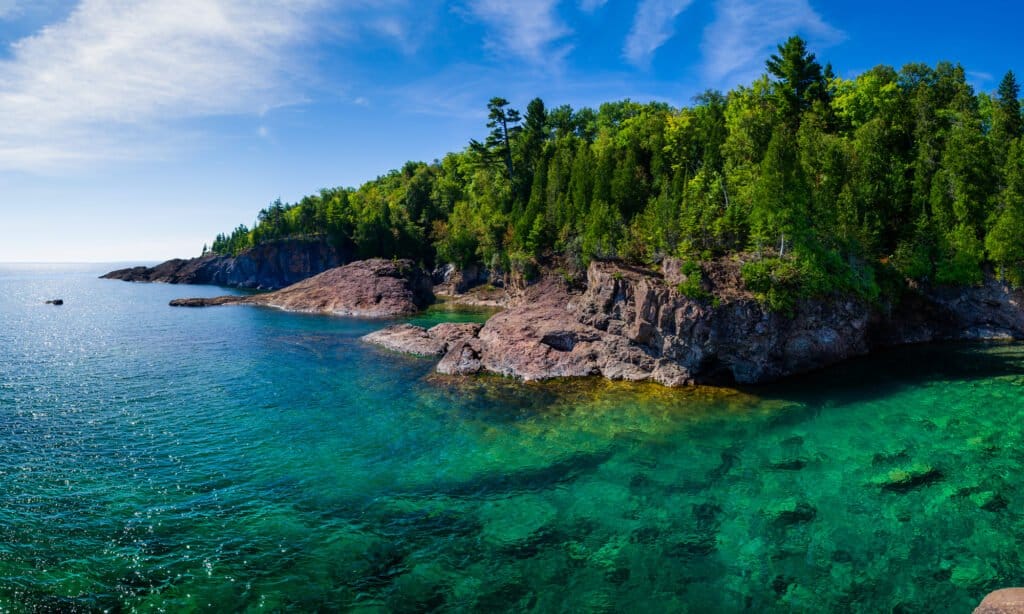Lake Superior is one of the most fascinating bodies of water on the planet. Legends abound about this greatest of the Great Lakes – from ghosts of it’s hundreds of shipwrecks to rumors of a secret, underground cave – Lake Superior has been the subject of many stories and songs. What lurks underneath it’s crystal clear, icy depths? Just how deep is Lake Superior?
Lake Superior is one of the five North American Great Lakes and is considered the largest among all freshwater lakes globally. Based on its surface area, it surpasses all other freshwater lakes in the world (which excludes the largest lake, the Caspian Sea, as it is a saline lake). Lake Superior holds many titles and has many records, including holding 10% of all the world’s surface freshwater. Yes, that’s how big it is! But apart from all these titles and records, Lake Superior has more things to offer, such as a diverse freshwater ecosystem and amazingly clear underwater visibility! Despite the lake’s enormous surface area, it still doesn’t rank among the world’s top 10 deepest lakes. But that doesn’t mean it is not deep. So, how deep do you think Lake Superior is? This article will answer that and more!

Where is Lake Superior on a Map?
Lake Superior is the most northern and western of the Great Lakes. Canada and the US share the lake’s waters. The northernmost banks of Lake Superior are almost directly in line, latitudinally, with the US and Canadian borders of Washington, Idaho, Montana, and North Dakota.
How Deep Is Lake Superior?

Lake Superior has a maximum depth of 1332 feet.
©Elena Elisseeva/Shutterstock.com
The name Lake Superior gives justice to this vast body of water. It refers to the lake’s size and its position far North, which makes it the northernmost lake of all the North American Great Lakes. But apart from its wide surface area, Lake Superior also boasts a wowing depth of 1,332 feet or 406 meters. Given its expansive surface area that extends 160 miles (257 kilometers) wide and 350 miles (563 kilometers) long, it sure contains a massive volume of water. The lake’s overall surface area is 31,700 square miles holding a water volume of 2,900 cubic miles. Lake Superior has so much water that it surpasses even all the water of the other Great Lakes combined, plus three more Lake Erie’s! The lake is so enormous and has such a large volume that emptying it at its current rate (without offsetting water additions) would take 191 years.
Since Lake Superior’s deepest point goes down at 1,332 feet, it rarely freezes completely. However, despite the lake’s depth, it sports incredible clear water, boasting average underwater visibility of 27 feet or 8.2 meters, making it one of the world’s clearest and most pristine lakes. Some spots even reach 30 meters of underwater visibility. Like its name with the word “superior,” Lake Superior is indeed superior when it comes to having the clearest water among all five Great Lakes. The lake is studied to take about 200 years before it replaces its water and refills it with a new one. Lake Superior’s long-term lake-level variations are substantially lower than in any other Great Lakes. The lake-level fluctuations in Lake Superior are generally less than a yard due to its huge size and porous “dam” at its outlet.
Before going further, you can have a peek at what lives at the bottom of Lake Superior.
5 Incredible Lake Superior Facts
Now we’ve covered that key question, “How deep is Lake Superior?”, it’s time to examine many interesting facts define Lake Superior, including how it was formed 10,000 years ago, its rich biodiversity, how many ships it has taken over the years, and more. Lake Superior may be the largest freshwater lake, but it is a lot more. There are plenty of things you can say about Lake Superior, and like its water, you can never run out of words to describe it! Below, we will enumerate the top 5 most incredible facts about the largest and clearest Great Lake in North America.
1. Lake Superior rarely freezes completely.

The last time Lake Superior was entirely covered in ice was in 1996.
©Sorayot Chinkanjanarot/Shutterstock.com
Although located near the northernmost part of North America, Lake Superior rarely freezes completely. Like the other Great Lakes, Lake Superior is subject to lake-effect snow. However, the weather around the lake is generally mild, with temperatures warmer than offshore throughout the year. Winter temperatures around the reservoir rarely drop below -30 degrees Fahrenheit or -34 degrees Celsius, far exceeding inland values. June and July are typically tranquil, whereas October and November are prone to storms.
Lake Superior is covered in ice during winter seasons to the tune of 40% to 95%. However, the lake rarely freezes entirely. In 2014, Lake Superior froze over for the first time. In that year and the following year, ice covered around 95% of the lake. The Great Lakes had a 91 percent ice cover in that particular year, the highest freezing level since 1979. The last time Lake Superior was entirely covered in ice was in 1996.
2. Lake Superior was formed 10,000 years ago.

Lake Superior’s inland basin first took action nearly 1.2 billion years ago.
©LIKE HE/Shutterstock.com
Despite holding many incredible titles today, Lake Superior is one of the world’s youngest major features. Dating back to 10,000 years, Lake Superior’s last glacial retreat is far younger than other lakes that have been around since millions of years ago. The oldest known lake, for instance, is Lake Baikal in Russia. The Russian lake was formed about 25 million years ago.
Although coming to Earth not more than 10,000 years ago, Lake Superior’s inland basin first took action nearly 1.2 billion years ago due to the North American mid-continent rift, carving an arc-shaped depression that extends from Kansas to Minnesota. Lake Superior was derived from the French word lac supérieur, which translates to “upper lake.” It was given this name since it is located north of Lake Huron, which was discovered initially by French explorer, Étienne Brûlé. During the Colonial period, Lake Superior was a key route of transportation for the fur industry and other transactions involving trading, and it is still a shipping hub nowadays.
3. Lake Superior has rich wildlife.
Although Lake Superior’s climate is typically cold, rich wildlife amazingly inhabit it. Around 80 species of fish consider Lake Superior as their home, and these species include varieties of salmon, perch, and trout. As the largest of the Great Lakes, Lake Superior provides unrivaled fishing opportunities. Lake Superior holds a massive volume of water because of its enormous inland basin and the hundreds of rivers that feed it. Nearly 200 rivers act as Lake Superior’s water source. The largest rivers connecting to it include Nipigon, coming from the North, and St. Louis, from the west. That number alone proves the lake’s rich ecosystem, as fish coming from different rivers all swim down to Lake Superior! Apart from its connecting rivers, Lake Superior also hosts a vast island network, including Isle Royale, Madeline, Grand Islands, and Michipicoten. The largest island, Isle Royale, hosts a national park. This network of islands provides excellent fishing opportunities and gives home to tons of fish species.
Here are some of the fish species found in Lake Superior:
- Lake trout
- Salmon
- Walleye
- Smallmouth Bass
- Northern Pike
- Burbot
- Muskellunge
- Perch
- Pumpkinseed
Apart from a vast diversity of fish species, many typical native plant species also thrive in the Lake Superior region, like the nearly 60 orchid species around the lake’s basin. Like many other lakes, Lake Superior is also home to a diverse range of bird species, including kingfishers, sparrows, herons, hawks, owls, and woodpeckers. The lake’s northern shore hosts approximately 10,000 migrating birds during migration season.
4. If you drain North America, Lake Superior will be the third-lowest point in the continent.

At 733 ft below sea level, Lake Superior is the second-lowest spot in the continental interior of the United States.
©JordanSchopper/Shutterstock.com
Lake Superior is the second-lowest point in the continental interior of the entire United States and the third lowest point in whole North America after the Great Slave Lake in Canada. Although Crater Lake in the United States is far deeper than Lake Superior, the former lake’s elevation is higher than Lake Superior. J. Val Klump, an American limnologist, was the first person to ever reach the deepest point of Lake Superior in 1985.
5. Lake Superior has a record of 350 shipwrecks.

With a record of 350 shipwrecks, Lake Superior has claimed about 10,000 lives.
©Mario Dias/Shutterstock.com
Along with the other Great Lakes, Lake Superior has been subject to maritime mishaps over the years due to varied depths and unpredictable weather. Despite the lake’s stunning appearance and wildlife, Lake Superior has a record of 350 shipwrecks in total and has claimed more or less 10,000 lives over the years. Due to icy waters, these lives have perished, and some were never recovered. The Great Lakes have thousands of shipwreck records in total because, unlike in the oceans, there are no natural harbors for ships to dock when massive storms happen. Most of Minnesota’s recorded shipwreck incidents happened in Lake Superior. The last ship to sink in the lake’s waters was the SS Edmund Fitzgerald in 1975, carrying iron ore. The ship was the largest to sail across North America’s Great Lakes and the most significant ship tragedy in the area. The ship held 29 crew who all perished with the ship.
Lake Superior is an enormous body of water that hosts a very rich marine biodiversity. If stretched, the lake can extend as long as Duluth, Minnesota, and the Bahamas combined. This incredible part of nature offers home and food for various ecosystems and human populations, so the least we can do is to respect and preserve its beauty.
The photo featured at the top of this post is © Mario Dias/Shutterstock.com
Thank you for reading! Have some feedback for us? Contact the AZ Animals editorial team.







